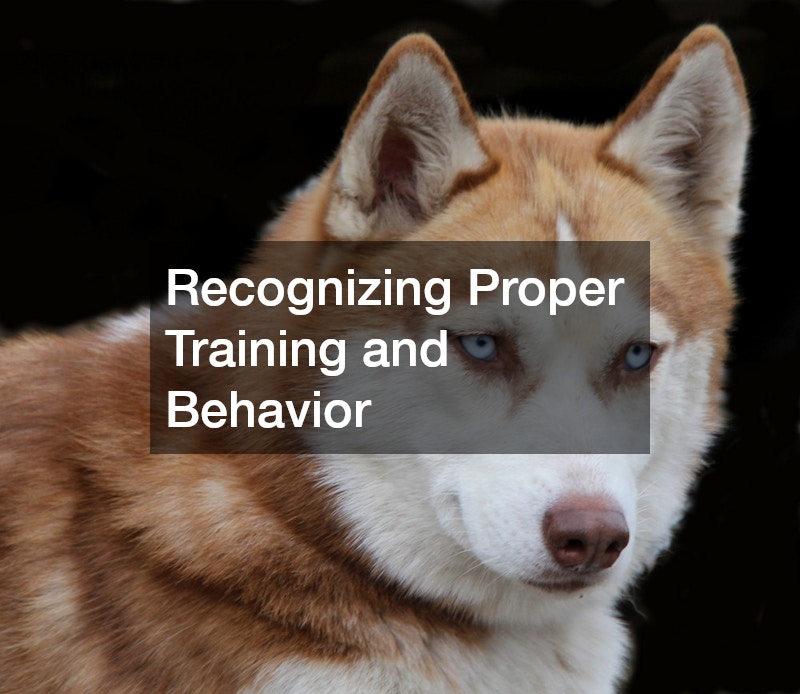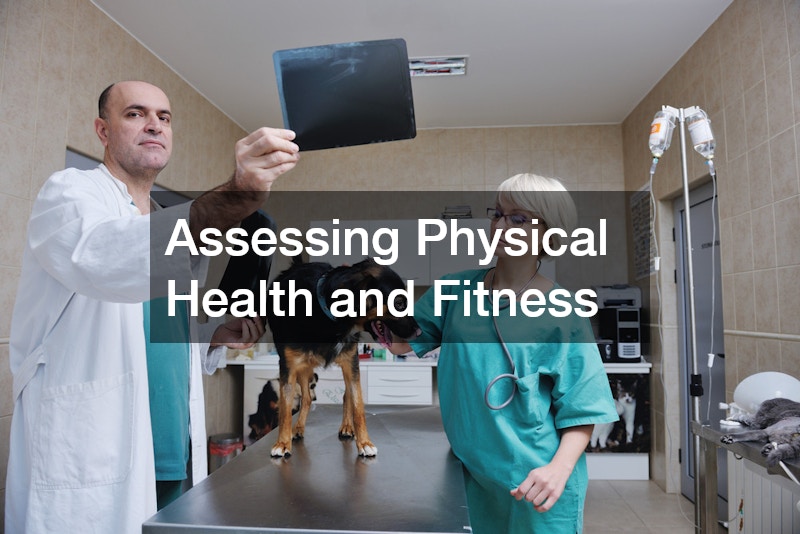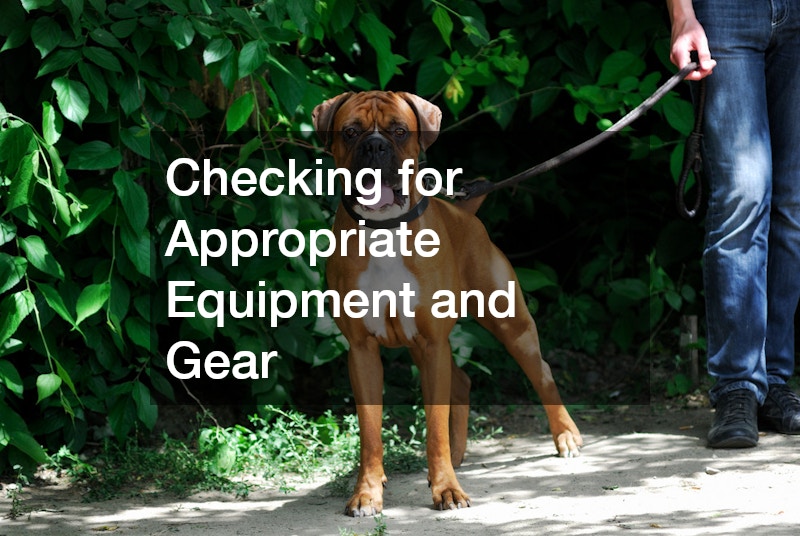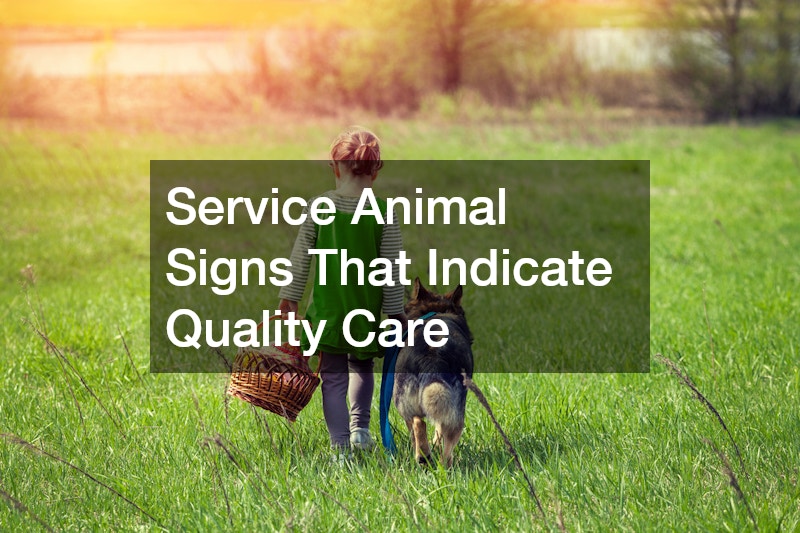
Human Animal Symbiosis
Service animals play a crucial role in assisting individuals with disabilities, providing not just companionship but also essential support in daily activities. Ensuring that these animals receive the highest quality care is vital for their well-being and effectiveness. Recognizing the signs of good care can help handlers and those around them understand if a service animal is being well-tended. This blog will explore various indicators of quality care for service animals, offering insights into what to look for to ensure these invaluable companions are healthy, happy, and capable of performing their duties effectively.

Recognizing Proper Training and Behavior
One of the most telling of quality care is the animal’s behavior and training. A well-cared-for service animal will display proper training by responding promptly to commands and behaving appropriately in various situations. These animals are trained to remain calm, focused, and attentive, even in potentially distracting environments. This level of training not only ensures the safety and effectiveness of the service animal but also reflects the dedication and care of the handler. Observing how a service animal interacts with its handler and the environment can provide clear indications of the quality of care it receives.
Specifically, recognizing proper training and behavior can be akin to noticing how a tree removal service operates with precision and care. Just as professionals in tree removal meticulously handle their tasks, ensuring no harm comes to the surroundings, a well-trained service animal will perform its duties with similar precision. These animals are trained to avoid distractions and hazards, much like a tree removal team would carefully navigate obstacles to complete their job efficiently. This parallel highlights the importance of proper training and the impact it has on the service animal’s ability to perform its essential functions.
A service animal’s good behavior, such as responding promptly to commands and remaining calm in various situations, signifies excellent training. This reflects the handler’s dedication to consistent training and care, ensuring the animal’s ability to perform its duties effectively and safely, demonstrating high-quality care.
Observing Cleanliness and Grooming
Cleanliness and grooming are essential service animal signs indicating quality care. A service animal that is regularly bathed, brushed, and maintained will have a healthy coat and clean appearance. Proper grooming not only keeps the animal looking good but also prevents potential health issues such as skin infections, matting, and parasites. Regular grooming sessions are also an opportunity for the handler to check for any abnormalities, such as lumps, cuts, or other signs of illness. A well-groomed service animal is a clear indicator that the handler is attentive to the animal’s overall health and well-being.
In the same way, a local roofer ensures the exterior of a house is well-maintained and protected from the elements, maintaining the cleanliness and grooming of a service animal is crucial for its health and functionality. Just as a roofer would regularly inspect and repair any damage to prevent leaks and structural issues, a handler must regularly groom their service animal to prevent health problems and ensure it remains in optimal condition. This comparison underscores the importance of routine care and attention to detail in maintaining the health and effectiveness of a service animal.
Having your service animal well groomed is crucial for maintaining its health and hygiene. Regular grooming prevents skin infections, matting, and parasites, while also keeping the animal comfortable and clean. It reflects attentive care and ensures the animal can perform its duties effectively without discomfort or health issues. Keeping your service animal clean is simply part of the responsibility package.

Assessing Physical Health and Fitness
One of the most visible service animal signs of quality care is the animal’s physical health and fitness. A healthy service animal will exhibit a shiny coat, bright eyes, and good body condition. Regular exercise is crucial for maintaining their physical health, allowing them to perform their duties effectively. Ensuring that a service animal receives the appropriate amount of physical activity and a balanced diet is essential for its overall well-being. Observing a service animal’s energy levels and physical condition can provide insights into the level of care it receives.
In a similar manner to how a window tinting service ensures that vehicles are protected from harmful UV rays and glare, maintaining the physical health and fitness of a service animal protects it from potential health issues. Just as window tinting service providers focus on enhancing visibility and comfort, handlers must focus on the physical upkeep of their service animals. Regular vet check-ups, exercise routines, and a nutritious diet are the building blocks of a healthy and fit service animal, ensuring it can serve its handler effectively and safely.
Identifying Consistent Medical Check-Ups
Consistent medical check-ups are critical service animal signs that indicate quality care. Regular veterinary visits help in early detection and treatment of any health issues, ensuring that the service animal remains in good health. Preventative care, such as vaccinations, dental care, and routine blood tests, are essential aspects of maintaining the animal’s health. A service animal that receives regular medical check-ups is more likely to remain healthy and capable of performing its duties without interruption.
Identifying consistent medical check-ups can be likened to the process of rodent control in maintaining a clean and safe environment. Just as rodent control professionals regularly inspect and treat areas to prevent infestations, handlers must ensure their service animals are regularly seen by a veterinarian. This proactive approach helps in managing and preventing potential health problems, much like how consistent rodent control prevents pest issues. Regular medical care is a cornerstone of quality care, ensuring the service animal can continue to support its handler effectively.

Evaluating Socialization Skills and Temperament
Another important service animal sign of quality care is the animal’s socialization skills and temperament. A well-cared-for service animal will be well-socialized, displaying calm and friendly behavior towards people and other animals. Socialization is crucial for service animals as they often need to navigate public spaces and interact with various individuals. An animal with a good temperament will be less likely to experience stress or exhibit aggressive behaviors, making it more effective in its role.
Evaluating socialization skills and temperament can be compared to a drain cleaning service maintaining clear and functional plumbing systems. Just as drain cleaning services ensure that pipes are free of blockages and working smoothly, proper socialization ensures that a service animal can operate in various environments without issues. Regular exposure to different settings and positive reinforcement helps in developing a service animal’s ability to remain calm and composed, much like how routine maintenance keeps a plumbing system in optimal condition. This comparison highlights the importance of socialization in ensuring a service animal’s effectiveness and well-being.
Understanding Nutrition and Diet Standards
Understanding proper nutrition and diet standards is one of the essential service animal signs that indicate quality care. A balanced diet tailored to the specific needs of the service animal ensures it has the energy and nutrients required to perform its duties effectively. This includes providing high-quality food, appropriate portion sizes, and regular feeding schedules. A well-nourished service animal will exhibit signs of good health, such as a shiny coat, clear eyes, and an appropriate weight.
Like how a residential cleaning service meticulously maintains a clean and healthy living environment, handlers must be diligent in providing a nutritious diet for their service animals. Just as a cleaning service ensures that all areas are free from dirt and allergens, a proper diet keeps the service animal’s body free from nutritional deficiencies and related health issues. The attention to detail in both scenarios is crucial for maintaining overall well-being, highlighting the importance of a carefully managed diet for service animals.

Checking for Appropriate Equipment and Gear
Appropriate equipment and gear are vital service animal signs that demonstrate quality care. Service animals often require specific equipment, such as harnesses, vests, and leashes, that enable them to perform their duties effectively and safely. Ensuring that this equipment is of high quality, well-maintained, and properly fitted is crucial for the comfort and functionality of the service animal. Proper gear not only supports the animal’s physical well-being but also enhances its ability to assist its handler efficiently.
In the same way, a carpet installer ensures that carpets are fitted correctly to avoid any discomfort or safety hazards, handlers must ensure that their service animals have the appropriate gear. Just as a well-installed carpet provides comfort and durability, properly fitted equipment ensures the service animal can perform its tasks without hindrance. Regular checks and maintenance of this gear are necessary to prevent wear and tear, emphasizing the importance of high-quality and suitable equipment in providing quality care for service animals.
Ensuring Compliance with Legal Regulations
Ensuring compliance with legal regulations is another critical service animal sign that indicates quality care. Service animals and their handlers must adhere to specific laws and guidelines to ensure the animal’s presence is legitimate and recognized. This includes having proper documentation, identification, and adhering to public access laws. Compliance with these regulations not only legitimizes the service animal’s role but also protects the rights of the handler and the public.
Similar to how a mold removal contractor must follow strict regulations to safely and effectively remove mold, handlers of service animals must comply with legal requirements to ensure their animals are appropriately recognized and allowed in various settings. Just as mold removal involves adhering to safety standards and protocols, maintaining compliance with service animal regulations involves understanding and following the laws that govern their use. This comparison highlights the importance of legal compliance in ensuring that service animals can perform their duties without legal complications.
Monitoring Emotional Well-Being and Support
Monitoring emotional well-being and providing support are essential service animal signs that indicate quality care. Just like humans, service animals can experience stress, anxiety, and emotional fatigue. Ensuring that these animals receive adequate mental stimulation, rest, and positive reinforcement is crucial for their overall well-being. Recognizing signs of stress or behavioral changes can help handlers address any issues promptly, ensuring the service animal remains emotionally balanced and effective in its role.
In a similar vein to how fence installation provides security and a sense of boundaries, ensuring the emotional well-being of a service animal creates a stable and supportive environment. Just as a well-installed fence protects and defines property, emotional support and proper care help maintain the mental health of the service animal. This comparison underscores the importance of a nurturing and secure environment in promoting the overall health and functionality of service animals.
Recognizing Effective Communication and Commands
Effective communication and command recognition are vital service animal signs that highlight quality care. A well-trained service animal should respond accurately to a variety of commands, ensuring they can assist their handler effectively in different situations. This level of communication is achieved through consistent training and reinforcement, which fosters a strong bond and understanding between the handler and the service animal.
This can be compared to how a local landscaper enhances the aesthetics and functionality of an outdoor space through effective planning and execution. Just as a landscaper must communicate and implement a vision to create a harmonious environment, a service animal must understand and respond to commands to perform its duties successfully. This parallel emphasizes the importance of clear communication and consistent training in maintaining a service animal’s efficiency and reliability.
Professional Service Animal
In conclusion, recognizing the various service animal signs that indicate quality care is crucial for ensuring the health, well-being, and effectiveness of these indispensable companions. Proper training and behavior, cleanliness and grooming, physical health and fitness, consistent medical check-ups, socialization skills and temperament, nutrition and diet standards, appropriate equipment and gear, compliance with legal regulations, emotional well-being, and effective communication are all key indicators of quality care. By paying close attention to these signs, handlers and the public can ensure that service animals receive the care they need to perform their roles effectively and safely. Quality care not only enhances the service animal’s ability to assist but also ensures a harmonious and supportive relationship between the animal and its handler.
